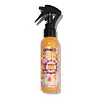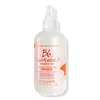What's inside
What's inside
 Key Ingredients
Key Ingredients

 Benefits
Benefits

 Concerns
Concerns

 Ingredients Side-by-side
Ingredients Side-by-side

Water
Skin ConditioningCetearyl Alcohol
EmollientButylene Glycol
HumectantPEG-12 Glyceryl Dimyristate
Skin ConditioningVitis Vinifera Seed Oil
EmollientPrunus Amygdalus Dulcis Oil
Skin ConditioningMacadamia Integrifolia Seed Oil
Skin ConditioningCocos Nucifera Oil
MaskingGardenia Taitensis Flower Extract
Skin ConditioningArgania Spinosa Kernel Oil
EmollientCarthamus Tinctorius Seed Oil
MaskingHydroxypropyltrimonium Hydrolyzed Corn Starch
Hydrolyzed Vegetable Protein Pg-Propyl Silanetriol
Skin ConditioningHydrolyzed Wheat Protein Pg-Propyl Silanetriol
Skin ConditioningDimethicone
EmollientGlycerin
HumectantSodium Hyaluronate
HumectantBehentrimonium Methosulfate
Distearyldimonium Chloride
Dimethiconol
EmollientCetrimonium Chloride
AntimicrobialButyl Methoxydibenzoylmethane
UV AbsorberEthylhexyl Methoxycinnamate
UV AbsorberSodium Chloride
MaskingCitric Acid
BufferingBHT
AntioxidantParfum
MaskingHexyl Cinnamal
PerfumingLinalool
PerfumingLimonene
PerfumingPotassium Sorbate
PreservativePhenoxyethanol
PreservativeWater, Cetearyl Alcohol, Butylene Glycol, PEG-12 Glyceryl Dimyristate, Vitis Vinifera Seed Oil, Prunus Amygdalus Dulcis Oil, Macadamia Integrifolia Seed Oil, Cocos Nucifera Oil, Gardenia Taitensis Flower Extract, Argania Spinosa Kernel Oil, Carthamus Tinctorius Seed Oil, Hydroxypropyltrimonium Hydrolyzed Corn Starch, Hydrolyzed Vegetable Protein Pg-Propyl Silanetriol, Hydrolyzed Wheat Protein Pg-Propyl Silanetriol, Dimethicone, Glycerin, Sodium Hyaluronate, Behentrimonium Methosulfate, Distearyldimonium Chloride, Dimethiconol, Cetrimonium Chloride, Butyl Methoxydibenzoylmethane, Ethylhexyl Methoxycinnamate, Sodium Chloride, Citric Acid, BHT, Parfum, Hexyl Cinnamal, Linalool, Limonene, Potassium Sorbate, Phenoxyethanol
 Reviews
Reviews

Alternatives
Ingredients Explained
These ingredients are found in both products.
Ingredients higher up in an ingredient list are typically present in a larger amount.
Limonene is a fragrance that adds scent and taste to a formulation.
It's found in the peel oil of citrus fruits and other plants such as lavender and eucalyptus. The scent of limonene is generally described as "sweet citrus".
Limonene acts as an antioxidant, meaning it helps neutralize free radicals.
When exposed to air, oxidized limonene may sensitize the skin. Because of this, limonene is often avoided by people with sensitive skin.
The term 'fragrance' is not regulated in many countries. In many cases, it is up to the brand to define this term. For instance, many brands choose to label themselves as "fragrance-free" because they are not using synthetic fragrances. However, their products may still contain ingredients such as essential oils that are considered a fragrance.
Learn more about LimoneneParfum is a catch-all term for an ingredient or more that is used to give a scent to products.
Also called "fragrance", this ingredient can be a blend of hundreds of chemicals or plant oils. This means every product with "fragrance" or "parfum" in the ingredients list is a different mixture.
For instance, Habanolide is a proprietary trade name for a specific aroma chemical. When used as a fragrance ingredient in cosmetics, most aroma chemicals fall under the broad labeling category of “FRAGRANCE” or “PARFUM” according to EU and US regulations.
The term 'parfum' or 'fragrance' is not regulated in many countries. In many cases, it is up to the brand to define this term.
For instance, many brands choose to label themselves as "fragrance-free" because they are not using synthetic fragrances. However, their products may still contain ingredients such as essential oils that are considered a fragrance by INCI standards.
One example is Calendula flower extract. Calendula is an essential oil that still imparts a scent or 'fragrance'.
Depending on the blend, the ingredients in the mixture can cause allergies and sensitivities on the skin. Some ingredients that are known EU allergens include linalool and citronellol.
Parfum can also be used to mask or cover an unpleasant scent.
The bottom line is: not all fragrances/parfum/ingredients are created equally. If you are worried about fragrances, we recommend taking a closer look at an ingredient. And of course, we always recommend speaking with a professional.
Learn more about Parfum